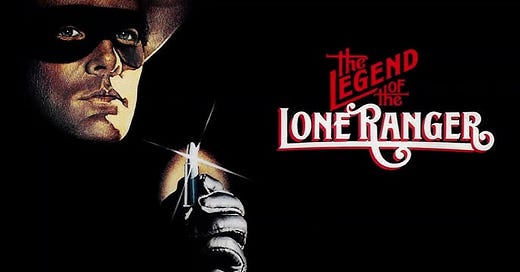FORGOTTEN FILMS ARCHIVE: 'The Legend of The Lone Ranger (1981)' Isn't the Total Failure It's Made Out To Be
Sometimes, a film can surprise you in a good way, even when it still isn’t that great. It’s all about expectations, which were floating in a stagnant pool of water at the bottom of the barrel when I decided to give the 1981 attempted epic western The Legend of The Lone Ranger a chance. Expecting total disaster, I was pleasantly surprised when this infamous bomb was, in fact, quite watchable.
That isn’t to say The Legend of The Lone Ranger is a hidden masterpiece. It’s not to say it is necessarily a good movie, either. There are glaring issues and insurmountable problems right at the heart of the picture, but there are also some redeemable qualities, fun performances, and a few stirring moments that make it at least an easygoing, entertaining time.
The story of this film is perhaps more fascinating than the final product. Inspired by the epic scope and success of 1978’s Superman, Jack Wrather, the oil billionaire who purchased the rights to the character way back in 1954, wanted to give the Lone Ranger the same treatment. He envisioned a sprawling, epic origin story, and right on the heels of Superman’s success, the film was green lit. And, just like with Superman, the goal was to hire an unknown in the starring role.
Their ultimate decision to hire a photographer named Klinton Splisbury as John Reid is where the film began to unravel. Spilsbury looked right in the mask (“his eyes weren’t too close together,” according to producer Martin Starger), and he is a tall, imposing figure, but apparently everything else about him was calamitous. Not only could he not deliver any of his lines in a convincing manner - so much so that actor James Keach was brought in to dub over every single one of his lines - but he would demand script rewrites and got into several altercations on set, his ego swelling to unmanageable levels. “He did things that simply hindered production,” Christopher Lloyd, who played Butch Cavendish, recalled.
The second misstep in the production of Lone Ranger involved a voiceover from country-music legend Merle Haggard. The idea must have sounded perfect at the time, but the execution of the narration is sloppy and it pulls the viewer right out of the film. Suddenly, Haggard’s narration pops up, explaining thoughts and actions of characters as we see them happening on the screen, adding nothing to the pathos, and making everything feel a little cheaper, like an episode of Dukes of Hazzard.
There was also the issue of Clayton Moore, who played the original Lone Ranger in the television series. At the time of the shoot, the 65-year old Clayton Moore was still making dozens of appearances every year as the character. Wrather wanted to balance a tribute to the original serialized character with a new, fresh take on the story, where Tonto’s history and Reid’s story have more weight, more mythology. This meant Moore, at least according to Wrather, needed to stop his convention appearances. It doesn’t make sense, and all it did was lead to a nasty lawsuit, therein starting the film off on the wrong foot with negative buzz it could never overcome.
The central argument against the film, which led to a tidal wave of negative press and a cataclysmic box office failure, was it took far too long to get our hero, John Reid, into the iconic mask and outfit the Lone Ranger wears. Even those criticisms were hyperbolic about how long it takes Reid to become the Ranger, claiming it was over seventy minutes into a 97-minute movie before we see the Lone Ranger. Setting aside the fact that Reid becomes the Ranger in just under an hour, not seventy minutes, the sequences leading up to his first appearance in the costume involve an ambush by Butch Cavendish’s gang, Tonto rescuing the grown-up Reid, nursing him back to health, teaching him how to shoot with silver bullets, and commandeering the wild stallion, Silver. There is more than enough satisfying world building and adventure before the final act is exclusively the Lone Ranger in action. In this regard, it follows the similar structure of the original Superman.
Certain elements hit well, like the William Tell Overture, and the soft lighting that evokes a very specific era of American filmmaking. Much of this film resembles those early, gauzy scenes in Superman. The vibes are not half bad. On top of that, everyone else outside of Spilsbury and Michael Horse (not an actor himself at the time), who is rather dry and uninspiring as Tonto, the cast is impressive. Lloyd is solid as the villainous Cavendish, though his performance is oddly muted, and Jason Robards is fun as President Ulysses Grant in the final act when his traincar is hijacked by the Cavendish Gang. There is also the western mainstay, Matt Clark, Richard Farnsworth as Wild Bill Hickock, and plenty of terrific Old West faces to fill out the crowd and compensate for Splislbury’s wooden performance.
The Legend of The Lone Ranger opened on May 22, 1981 and landed with a thud, in fourth place, with a paltry $2.9 million on its way to just over $12 million in ticket sales. It wasn’t even able to recoup its modest $18 million budget. The film may not necessarily warrant reappraisal, and it isn’t some hidden gem that got a bad rap at the time. It’s not great, barely good, but when you go into something expecting something so bad it makes you angry, hitting the end credits with a satisfying feeling is a pleasant surprise.





I didn't really know anything about this, so, really, a great rundown!
Fromtheyardtothearthuse.substack.com